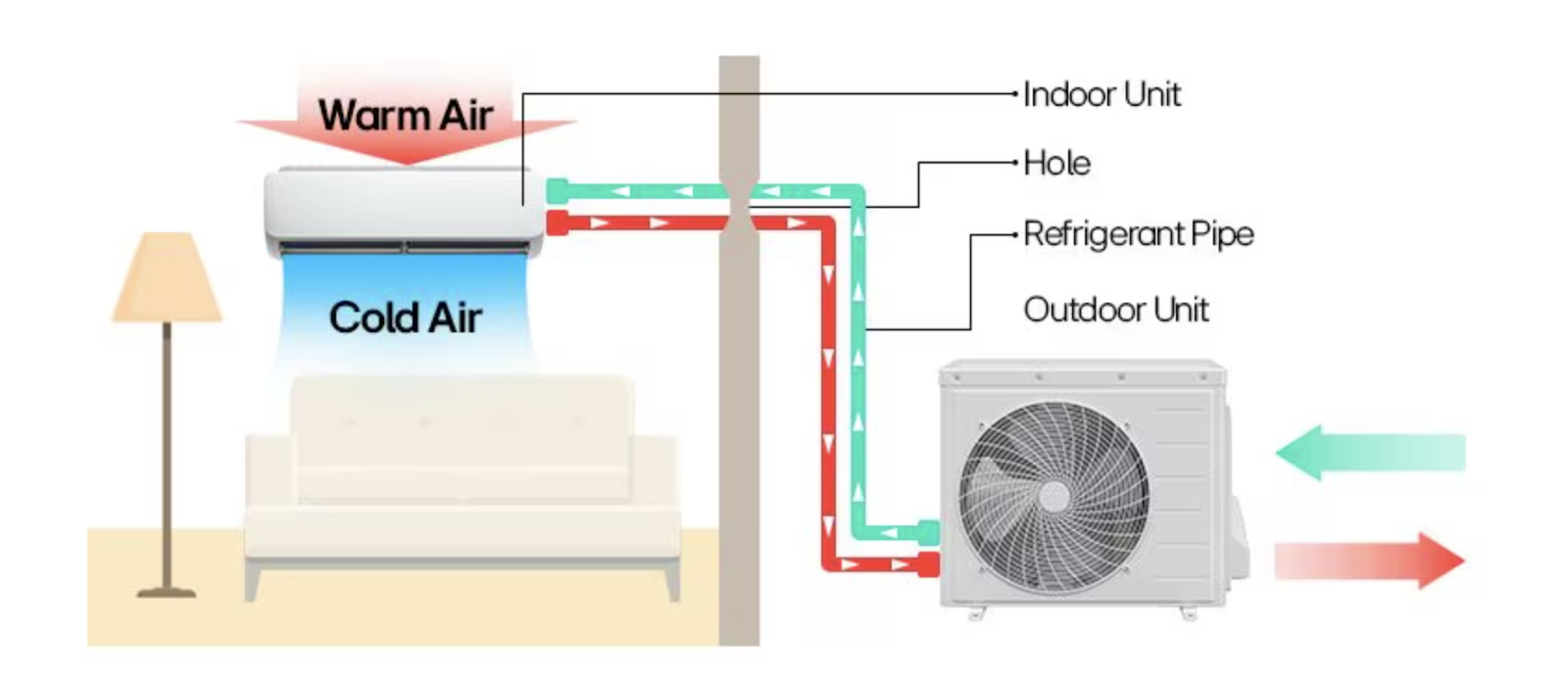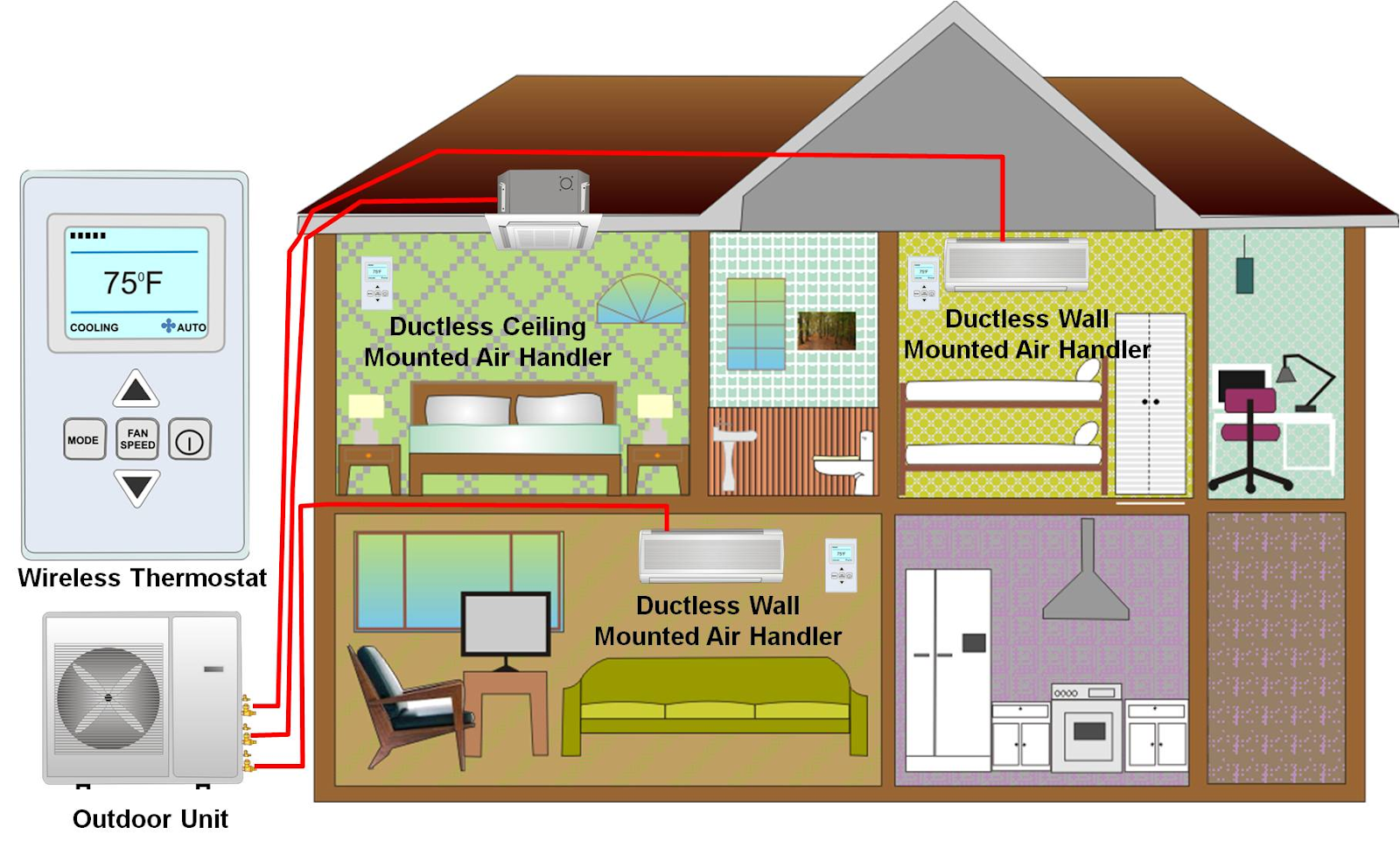When deciding on one’s home HVAC system, the main topics of importance or functionality, cost, energy and environmental conservation and aesthetics. One aspect that should be more closely examined to understand if your HVAC plan meets these needs is ductwork. Do you have ductwork? Do you need ductwork? Maybe a duct-free split HVAC system is the one for you.
Many homes and buildings already have ductwork. Ductwork uses ducts and vents to transfer hot or cold air throughout a home. The installation or renovation of ductwork can be costly and requires regular maintenance. The extensive routes of ducts take up a lot of space in the ceiling or floor and have to be cleaned regularly. Additionally, they are known to break down over time. Holes and cracks in the ductwork leak air, making them less energy efficient. They also allow dust or dirt to enter, contaminating the air in one’s home.
What is a duct-free split?
This HVAC system goes by many names: ductless mini split, ductless multi split, duct-free split, duct-free mini split… you get the point. In general, they are all roughly the same. Ductless HVAC is exactly how it sounds: heating and air conditioning without ductwork.
A condenser outside of a home or building uses refrigerant to take in or remove heat through one or many indoor units. The condenser and indoor units are connected through refrigerant lines and wiring. Typically, ductless units are for heat pumps, meaning they are used for both cooling and heating.

Image source: LG
Two main types
You can either have a single-zone ductless system or a multi-zone ductless system. Single-zone systems connect to one indoor unit dispensing cold or hot air. These are perfect for a small home, condo or apartment. They are efficient to cool or heat your entire space all year round.
However, if you have a large home or building with many rooms, the multi-zone ductless system may be a better choice. Think about the summer when you go to your basement and it’s freezing cold on an 80 degree day while the top floor bedroom is hot. Often, ductwork isn’t able to circulate air to evenly distribute heat across many floors.
A multi-zone ductless heat pump comes with five or even eight different indoor units that connect to one outdoor condenser. The indoor units can be set to different temperatures for the various needs of your different rooms. You can choose which rooms might need the most love and attention: the ones that are frequented the most and need to be more comfortable.
Variability for aesthetics
There are many different ways to install or mount a ductless mini split. This variety allows for the opportunity to select a unit that best fits a desired aesthetic and matches one’s home. Your anatomical comfort shouldn’t interfere with your ambient floor plan!
There are wall mounted and floor mounted mini splits. The wall mounted system, hence the name, is mounted to the wall and offers discreet, minimalistic designs with proper installation. Floor mounted units usually sit on the floor and are perfect for scalene or abnormal room designs.
An upgraded version would be a ceiling cassette, installed directly into the ceiling, or even a more discreet, concealed cassette where the mini split is installed above the ceiling. These designs offer even more floor space.
If you already have ductwork and don’t want to renovate to switch over to a mini split system, a vertical air handler can connect to existing ductwork. It uses refrigerant lines and can be multi-zone, replacing traditional hvac with higher efficiency.

Image source: Office of Energy Efficiency and Renewable Energy
Answering frequent questions
When deciding on an HVAC system, many want to know which is the most cost effective. It’s hard to say because it depends on the design of the home or building, how many rooms you want to attend to and what the existing HVAC looks like. If there is existing ductwork, the renovation cost to remove it might not make it worth it to invest in a ductless system.
What about noise? Ductless mini splits are quieter than traditional systems with ductwork. There is no “ping” sound from the expanding or contracting of ductwork from heat, or rattle of metal parts.
Maintenance is still required. Ductless mini splits should be cleaned semi-regularly to ensure consistently clean air.
As for energy efficiency, ductless systems save more energy, and money, in the long run because they don’t leak air through cracks or holes in the equipment. There is also less to install so it’s less likely things will be installed incorrectly.
One of the most important things to note for switching over to a new HVAC system like the duct-free split, is proper installation. A unit can be a great brand with reliable parts, but might break down or fail to function correctly without the proper installation. Most recognized brands have excellent customer service and are more than willing to help with installation.
For duct-free splits, Northrich Co. confidently trusts LG for their parts and services, as well as Mitsubishi, Daikin, Samsung and Hitachi.
For more information on purchasing or installing a new ductless HVAC system, contact Northrich company. 216-581-4750 or go to www.northrich.com
